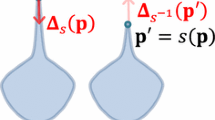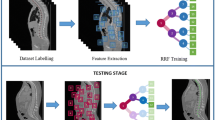Abstract
Purpose
The anatomical anomaly of the number of vertebral bones is one of the major anomalies in the human body, which can cause confusion of the spinal level in, for example, surgery. The aim of this study is to develop an automatic detection system for this type of anomaly.
Methods
We utilized our previously reported anatomical landmark detection system for this anomaly detection problem. This system uses a landmark point distribution model (L-PDM) to find multiple landmark positions. The L-PDM is a statistical probabilistic model of all landmark positions in the human body, including five landmarks for each vertebra. Given a new volume, the proposed algorithm applies five hypotheses (normal, 11 or 13 thoracic vertebrae, 4 or 6 lumbar vertebrae) to the given spine and attempts to detect all the landmarks. Then, the most plausible hypothesis with the largest posterior likelihood is selected as the anatomy detection result.
Results
The proposed method was evaluated using 300 neck-to-pelvis CT datasets. For normal subjects, the vertebrae of 211/217 (97.2%) of the subjects were successfully determined as normal. For subjects with 23 or 25 vertebrae without a transitional vertebra (TV), the vertebrae of 9/10 (90%) of the subjects were successfully determined. For subjects with TV, the vertebrae of 71/73 (97.3%) of subjects were judged as partially successfully determined.
Conclusion
Our algorithm successfully determined the number of vertebrae, and the feasibility of our proposed system was validated.










Similar content being viewed by others
References
O’Connor SD, Yao J, Summers RM (2007) Lytic metastases in thoracolumbar spine: computer-aided detection at CT-preliminary study. Radiology 242(3):811–816. doi:10.1148/radiol.2423060260
Letourneau D, Kaus M, Wong R, Vloet A, Fitzpatrick DA, Gospodarowicz M, Jaffray DA (2008) Semiautomatic vertebrae visualization, detection, and identification for online palliative radiotherapy of bone metastases of the spine. Med Phys 35(1):367–376. doi:10.1118/1.2820631
Knez D, Likar B, Pernus F, Vrtovec T (2016) Computer-assisted screw size and insertion trajectory planning for pedicle screw placement surgery. IEEE Trans Med Imaging 35(6):1420–1430. doi:10.1109/tmi.2016.2514530
Klinder T, Ostermann J, Ehm M, Franz A, Kneser R, Lorenz C (2009) Automated model-based vertebra detection, identification, and segmentation in CT images. Med Image Anal 13(3):471–482
Glocker B, Zikic D, Konukoglu E, Haynor DR, Criminisi A (2013) Vertebrae localization in pathological spine CT via dense classification from sparse annotations. Int Conf Med Image Comput Comput Assist Interv (MICCAI) 16(Pt 2):262–270
Huang SH, Chu YH, Lai SH, Novak CL (2009) Learning-based vertebra detection and iterative normalized-cut segmentation for spinal MRI. IEEE Trans Med Imaging 28(10):1595–1605. doi:10.1109/tmi.2009.2023362
Kelm BM, Wels M, Zhou SK, Seifert S, Suehling M, Zheng Y, Comaniciu D (2013) Spine detection in CT and MR using iterated marginal space learning. Med Image Anal 17(8):1283–1292. doi:10.1016/j.media.2012.09.007
Hsiang J (2011) Wrong-level surgery: a unique problem in spine surgery. Surg Neurol Int 2:47. doi:10.4103/2152-7806.79769
Lindley EM, Botolin S, Burger EL, Patel VV (2011) Unusual spine anatomy contributing to wrong level spine surgery: a case report and recommendations for decreasing the risk of preventable ’never events’. Patient Saf Surg 5(1):33. doi:10.1186/1754-9493-5-33
Carrino JA, Campbell PD Jr, Lin DC, Morrison WB, Schweitzer ME, Flanders AE, Eng J, Vaccaro AR (2011) Effect of spinal segment variants on numbering vertebral levels at lumbar MR imaging. Radiology 259(1):196–202. doi:10.1148/radiol.11081511
Hahn PY, Strobel JJ, Hahn FJ (1992) Verification of lumbosacral segments on MR images: identification of transitional vertebrae. Radiology 182(2):580–581. doi:10.1148/radiology.182.2.1732988
Castellvi AE, Goldstein LA, Chan DP (1984) Lumbosacral transitional vertebrae and their relationship with lumbar extradural defects. Spine 9(5):493–495
Wigh RE (1980) The thoracolumbar and lumbosacral transitional junctions. Spine 5(3):215–222
Nakajima A, Usui A, Hosokai Y, Kawasumi Y, Abiko K, Funayama M, Saito H (2014) The prevalence of morphological changes in the thoracolumbar spine on whole-spine computed tomographic images. Insights Imaging 5(1):77–83. doi:10.1007/s13244-013-0286-0
Yao J, O’Connor SD, Summers RM (2006) Automated spinal column extraction and partitioning. In: 3rd IEEE international symposium on biomedical imaging: nano to macro, 2006, IEEE, pp 390–393
Ma J, Lu L, Zhan Y, Zhou X, Salganicoff M, Krishnan A (2010) Hierarchical segmentation and identification of thoracic vertebra using learning-based edge detection and coarse-to-fine deformable model. Int Conf Med Image Comput Comput Assist Interv (MICCAI) 13(Pt 1):19–27
Glocker B, Feulner J, Criminisi A, Haynor DR, Konukoglu E (2012) Automatic localization and identification of vertebrae in arbitrary field-of-view CT scans. Int Conf Med Image Comput Comput Assist Interv (MICCAI) 15(Pt 3):590–598
Chu C, Belavy DL, Armbrecht G, Bansmann M, Felsenberg D, Zheng G (2015) Fully automatic localization and segmentation of 3D vertebral bodies from CT/MR images via a learning-based method. PloS ONE 10(11):e0143327. doi:10.1371/journal.pone.0143327
Chen C, Belavy D, Yu W, Chu C, Armbrecht G, Bansmann M, Felsenberg D, Zheng G (2015) Localization and segmentation of 3D intervertebral discs in MR images by data driven estimation. IEEE Trans Med Imaging 34(8):1719–1729. doi:10.1109/tmi.2015.2403285
Korez R, Ibragimov B, Likar B, Pernus F, Vrtovec T (2015) A framework for automated spine and vertebrae interpolation-based detection and model-based segmentation. IEEE Trans Med Imaging 34(8):1649–1662. doi:10.1109/tmi.2015.2389334
Daenzer S, Freitag S, von Sachsen S, Steinke H, Groll M, Meixensberger J, Leimert M (2014) VolHOG: a volumetric object recognition approach based on bivariate histograms of oriented gradients for vertebra detection in cervical spine MRI. Med Phys 41(8):082305. doi:10.1118/1.4890587
Major D, Hladuvka J, Schulze F, Buhler K (2013) Automated landmarking and labeling of fully and partially scanned spinal columns in CT images. Med Image Anal 17(8):1151–1163. doi:10.1016/j.media.2013.07.005
Hanaoka S, Shimizu A, Nemoto M, Nomura Y, Miki S, Yoshikawa T, Hayashi N, Ohtomo K, Masutani Y (2016) Automatic detection of over 100 anatomical landmarks in medical CT images: A framework with independent detectors and combinatorial optimization. Med Image Anal 35:192–214. doi:10.1016/j.media.2016.04.001
Hanaoka S, Masutani Y, Nemoto M, Nomura Y, Miki S, Yoshikawa T, Hayashi N, Ohtomo K (2013) A multiple anatomical landmark detection system for body CT images. In: 2013 First international symposium on computing and networking, 4–6 December, pp 308-311. doi:10.1109/CANDAR.2013.54
Murata N, Takenouchi T, Kanamori T, Eguchi S (2004) Information geometry of U-boost and bregman divergence. Neural Comput 16(7):1437–1481. doi:10.1162/089976604323057452
Nemoto M, Masutani Y, Hanaoka S, Nomura Y, Yoshikawa T, Hayashi N, Yoshioka N, Ohtomo K (2011) A unified framework for concurrent detection of anatomical landmarks for medical image understanding. SPIE Med Imaging. doi:10.1117/12.878327
Tu Z, Zhou XS, Bogoni L, Barbu A, Comaniciu D (2006) Probabilistic 3D polyp detection in CT images: the role of sample alignment. In: Computer vision and pattern recognition, 2006 IEEE computer society conference on IEEE, pp 1544–1551
Prokop RJ, Reeves AP (1992) A survey of moment-based techniques for unoccluded object representation and recognition. CVGIP Gr Models Image Process 54(5):438–460
Lowe DG (2004) Distinctive image features from scale-invariant keypoints. Int J Comput Vis 60(2):91–110
Geman S, Geman D (1984) Stochastic relaxation, Gibbs distributions, and the Bayesian restoration of images. IEEE Trans Pattern Anal Mach Intell 6(6):721–741
Hanaoka S, Masutani Y, Nemoto M, Nomura Y, Yoshikawa T, Hayashi N, Yoshioka N, Ohtomo K (2011) Probabilistic modeling of landmark distances and structure for anomaly-proof landmark detection. Proc Third Int Workshop Math Found Comput Anat 2011:159–169
Kadoury S, Labelle H, Paragios N (2013) Spine segmentation in medical images using manifold embeddings and higher-order MRFs. IEEE Trans Med Imaging 32(7):1227–1238
Sawada Y, Hontani H (2012) A study on graphical model structure for representing statistical shape model of point distribution model. In: Ayache N, Delingette H, Golland P, Mori K (eds) Medical image computing and computer-assisted intervention—MICCAI 2012: 15th International conference, Nice, France, October 1–5, 2012, Proceedings, Part II. Springer, Berlin, pp 470–477. doi:10.1007/978-3-642-33418-4_58
Acknowledgements
This work was supported in part by JSPS Grants-in-Aid for Scientific Research KAKENHI Grant Numbers 15H01108 and 15K19775.
Author information
Authors and Affiliations
Corresponding author
Ethics declarations
Conflict of interest
The authors declare that they have no conflict of interest.
Ethical standards
All procedures performed in studies involving human participants were in accordance with the ethical standards of the institutional and/or national research committee and with the 1975 Helsinki Declaration, as revised in 2008(5). For this type of study, formal consent is not required.
Rights and permissions
About this article
Cite this article
Hanaoka, S., Nakano, Y., Nemoto, M. et al. Automatic detection of vertebral number abnormalities in body CT images. Int J CARS 12, 719–732 (2017). https://doi.org/10.1007/s11548-016-1516-y
Received:
Accepted:
Published:
Issue Date:
DOI: https://doi.org/10.1007/s11548-016-1516-y




